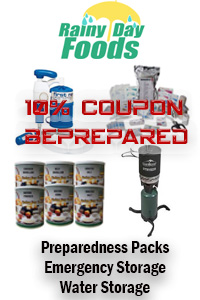Prepping is like investing in the stock market, there will be highs and lows but you must be steady with your inputs understanding that commons sense and patience wins the day. Certainly if one is starting from zero there is a baseline that must be achieved (typically this might look like 1 month of supplies on hand) but for those of us that have been in the game for a while we realize that it’s a marathon and not a sprint. More importantly we also realize whatever it is that we have on hand can usually be viewed as not enough – yet if SHTF happens you’ve got what you’ve got. If you have 30 days on hand you’ll want 90 days. If you have 5 years on hand you’ll strive for 10 and so on. There is one standard belief that I hold true: if I pass away as an old man and none of my long term SHTF storage was ever touched I’ll be happy. I don’t wish for the opportunity to have to live off of these items in a SHTF environment, anyone that does is an idiot. I prefer climate control, conveniences and a society where my wife and daughter can live and thrive. That said I do enjoy the occasional power outage where we run the generator for a night, justifies the cost and makes me look like a hero.
Key Points about Food Storage
1- Do what you feel is best: I’m not here to tell you what to store as everyone’s situation might be different. The main point is that you have something for the size family that you have, for the duration which you feel is necessary and can afford and that most importantly you take ownership of it. Calorie count wins the day over servings in my opinion and at minimum a month of stock should be enough for most situations.
2- Don’t do it all at once: Panic mode, swipe credit card, pallets of food delivered which are shuttled to basement, major event that struck panic doesn’t manifest itself and now that credit card bill is looking pretty thick. Not good, no bueno, yikes. Assuming one has a baseline of food storage I suggest chipping away at goals, maybe a purchase once or twice a year and before you know it the stocks will be looking nice. In the last 10 years I’ve seen people flip out and go crazy stocking up only to realize that whatever it was that triggered them didn’t manifest itself in the way they thought (read: Coronavirus). Who is to say what happens but I believe slow and steady wins the race, almost every time.
3- Environmental factors matter: How you store your food and water matters with respect to shelf life. Are they in direct sunlight, are they in a storage container in sweltering heat in the summer? Best case they are in a climate controlled basement or similar, I have my stuff in a garage which never really gets above 60 degrees here in the mountains. Definitely something to think about while planning the food storage options.
4- Do an inventory: I try to knock this out whenever I get more supplies in, if even to move things around and to knock the dust off of boxes / ensure mice aren’t nibbling on my supplies. FWIW I do have rodent prevention bait strategically placed in bait boxes around my supplies, don’t want the critters getting in there and spoiling things. Inventory usually consists of type, quantity, date of manufacture, calorie count and such. It’s much easier to reference this sort of report to fully understand that for X people, there are Y calories in the form of _______ on hand. Basically you can extrapolate that out and do a rough timeline of how long you’d have based on any given hunker down scenario. Add 1 person to the mix, that timeline drops by X days, etc etc.
5- Purchase from a reputable company: Really this boils down to do your research, read reviews and even call distributors or visit them to get a good vibe before purchasing. I’ve got stuff from Wise, Mountain House, Thrive, Augason Farms and much more. I tend to stick with the bigger brand names but that doesn’t mean that smaller companies aren’t producing quality products. When you are buying food for your family during harsh times which are supposed to have a 25-30 year shelf life I tend to not worry about paying a little more.
6- Understand the implications: Maybe it’s 2 years of freeze dried food storage that you bought and is now sitting in the basement. What exactly do you have? Some packages are structured with #10 cans of ingredients (flour, pancake batter, rice, beans) and others are structured as meals (lasagna, chicken casserole). Additionally consider the amount of water required to reconstitute those meals and if you have the capability to heat / boil water in a grid down environment.
7- Don’t forget the fur babies: Who doesn’t have a dog? Communists? I have 3 and I know how long a bag of dog food lasts and have stockpiled so that we have a few months worth. Certainly in a SHTF situation the dogs could survive off of people food but that’s not the best for their stomachs and dog food is relatively cheap, buying five 35lb bags really isn’t a stretch financially.
Layering Tips
Just a few tips with respect to layering which I thought about whist pushing a sled around Costco today. I typically have 3 broad categories related to food storage.
1- Canned food: I have quite a bit of canned food on a shelving unit in my garage. This is food that is ready to eat right now, just pop the top and go to town. This is also food that typically has an extended shelf life beyond what is stamped on the can, I recently opened a can of beans that “expired” in 2013 and they were fine. The downside to canned food is that quite a bit of room is taken up with respect to the amount of food stored and it’s more expensive when compared against big bulk storage. However I believe that canned food is a must have in any storage plan.
2- MRE’s: Easily recognizable, lots of calories, good for barter or traveling. Downside is that they have a relatively short shelf life, some estimate at around 7 years. I have around 5 cases in my garage that are approaching or are past that 7 year mark, I don’t plan on tossing them but it happens quicker than one might think. I think it’s fine to have a couple cases of MRE’s but I’d rather go with a Mountain House meal pack any day over an MRE in a pinch. MRE’s are certified nasty – just ask the guy who has 22 years of Army experience.
3- Long Term Storage: This is the big dog on the porch, long term food storage. Easily stackable, typically six #10 cans to a box and the sky is the limit. I also like buckets of staples like rice, beans, oats and other buckets of meal packets / macaroni and cheese or similar. I consider this type of storage the “deep waters” go to, in that things have gotten really bad and we are past a few days of hanging out in the house but are now into the weeks and months. I suggest doing some serious shopping when it comes to this, I’ve gone to some very popular survival websites and priced them only to find that Costco had the exact items online for a significant price reduction.
Final Thoughts
I was chatting with a friend today and we talked about how most people don’t have more than a few days worth of food stocks in their home. Our just in time economy, the convenience of pressing a button on a phone and having a meal show up or simply hopping in an Uber to find any number of restaurants. We want for nothing here and always have quick access to food, 24/7/365. I can’t help but wonder how chaotic things would get if that supply chain were to be disrupted for even a month. Let me know your thoughts below.









7 comments
Skip to comment form
I think society would become frantic in just a few days if not immediately if they lost electricity and knew it would be out for a while. This is especially true in big cities where people live to go out to eat and socialize. The loss of electricity for an extended time is my greatest concern. Most people ate very dependent on electricity and simply won’t know what to do if it is unavailable.
I have a food closet pantry just for survival food. Got some pre packed meals, Keeping in mind protein & calories.
Each shelf has an expiration date on front for quick reference. Got a lot of stuff that last years. Many packs sealed with food saver and silica gel packs. I rotate stock each year so nothing is wasted. Just buy a few extra items each week with groceries and it adds up. Don’t really make large Costco purchases. Mostly buy one get one free at regular grocery store. Flour, sugar, corn meal, etc sealed up with food saver. Spam!!! Gosh can we say enough about how long Spam last!!!!Still watching salt content for staying healthy also. Can my own veggies, fruits, & make my own jelly, jam & syrup. Not big on canning meats but do make jerky and seal it up. Coffee!!!!I Got to have coffee. Got old timey percolator to go on fire. Got tea sealed up. Honey has a long shelf life, great for sweetning. I too hope I never have to use it all up. Once without power for a week, used generator to keep fridge & freezer running. Have to say, it was one of the best weeks in a long time. Actually Sat & had conversations with hubby. Fished, played cards, read books during the day. Up with the chickens, to roost with the chickens. Just wish my grown kids & families were better prepared!
Lard…..don’t forget lard. Won’t spoil like vegetable shortning.
Can make a good biscuit or pan bread with out it!
Four years the house I had rented for 12 years sold. In that 12 years rent in our area had more than tripled. I’m a senior on Social Security & was raising 2 grandkids. I couldn’t find anything I could afford & had to move 50 miles away. To pay for new housing & cost of moving I had to take out 2 loans , the payments took almost half my monthly income. It was my own personal SHTF & thank goodness I had food preps. We ate from those for over a year so be prepared folks. You never know. Thanks for a good article.
Hey, PJ, great article! I hope you have also invested in heirloom seeds, fruit trees,berry bushes, etc. As well as hunting and fishing gear. I want to raise chickens, mostly for eggs, but the problem of how to feed them in a SHTF situation has stopped me so far. Have acreage but only piped in water which could easily dry up in a SHTF. There’s a river about ten miles away but that’s a long way to haul water especially by hand and foot! By the way, there are freeze-dried foods available in pouches (chicken, beef, pork, veggies, granola,etc.) that are much easily to haul than #10 cans, though I love those cans, read bug-out bag. GLAHP!
In addition, you should look into humanure (yea, human poop as fertilizer), in a SHTF you may not have any other options for fertilizing your garden. And if you haven’t already, you should turn your roof into a rain water collection system, good for the garden. GLAHP!
I started prepping last month…but living in SoCal, always had extra water on hand and a good supply of seeds. Anyway, became widowed last year at age 59 and realized it’s all on me. Now have a solid 2 months of food stored, over a month plus of water, also seeds, candles, flashlights, tools, shotgun, transistor radio, batteries, pet food, etc.
But, I am so worried bcuz I live an hour away from LA, off the 101 freeway and if we have any type of EMP, I have no way to get to my BOL. Staying here at home is too risky considering my proximity to LA and the 101…I am having a hard time finding an inexpensive old car that won’t be affected by an EMP.
Anyway, love the website, love reading folks comments, thanks!